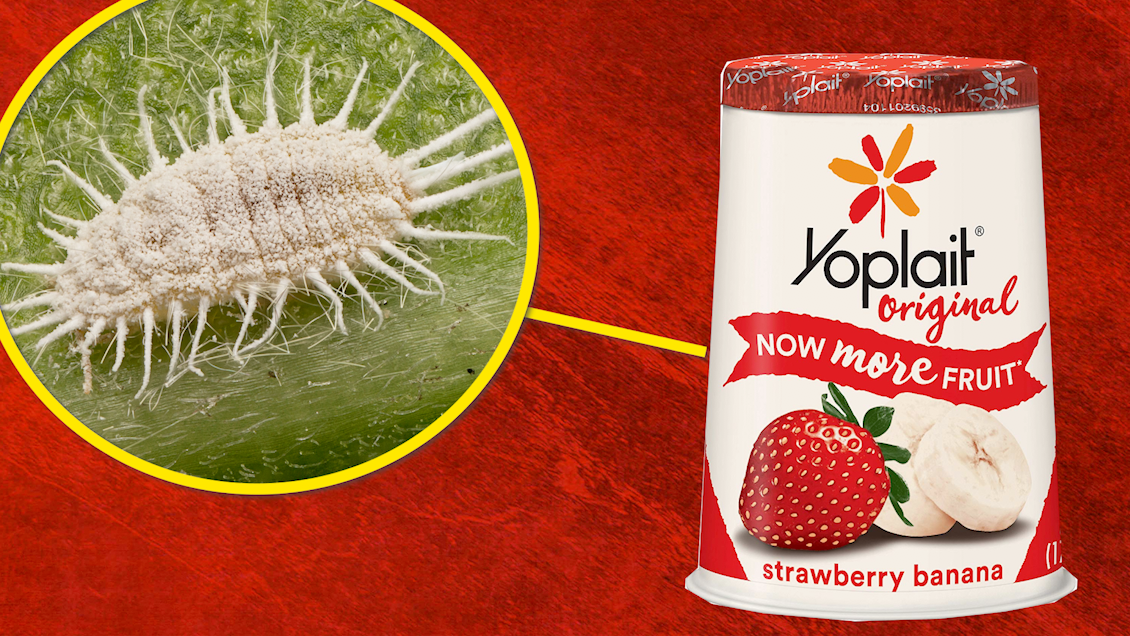- Yoplait original strawberry yogurt is one of many foods colored with carmine, a natural red dye derived from crushed cochineal bugs.
- People have used cochineal as a natural dye for thousands of years. But it wasn’t until the 20th century, when natural foods were on the rise, that carmine became a popular coloring in commercial foods.
- Yoplait is one of the few companies still coloring its foods with carmine, after blowback from the vegan community and people’s general distaste for eating bugs.
Following is a transcript of the video.
Narrator: No one likes finding bugs in their food when they’re not expecting it. But I hate to break it to you, you’re actually eating them all the time. I’m not just talking about the critters that end up in juices or jams by accident. Some bugs are in our food because, well, we put them there. If you think it’s fruit that turns this strawberry yogurt red, think again. Yes, there are in fact strawberries in there, but they’re there for flavor and texture, not color. That bright red comes from something else called carmine. Oh, and it’s made from squashed bugs. Squashed female cochineal bugs, to be specific. They’re tick-sized critters native to Mesoamerica where they suck the juice from prickly pear cactuses.
Nancy Greig: And if you squish them, they are bright red inside and kind of a purply, deep purple-red color, and that’s the source of cochineal, cochineal dye, carmine, whatever you wanna call it.
Narrator: For thousands of years, people have been using these bugs to dye everything from clothes to pottery. But it wasn’t until more recently that they made their way into commercial foods. From 1955 to 2010, the consumption of food coloring rose by 500% in the United States. That’s mostly thanks to artificial colors like Red 40, Yellow 5, and Blue 1. But in the late 20th century, consumers became increasingly concerned about synthetic chemicals in their foods and demanded more natural ingredients. So many companies turned to carmine. It’s FDA improved and tasteless. It resists degradation from light, heat, and oxidation, and unlike some synthetic colorants, it hasn’t been linked to cancers or tumor growth.
Greig: Now, some people apparently have allergies to it, but compared with the downsides of the chemical dye, it's very benign. It's like using beet juice.
Narrator: And just like that, carmine ended up in strawberry and cream Frappuccinos and cake pops at Starbucks, in Tropicana grapefruit juice, and, yes, in Yoplait yogurts. Just look for carmine or cochineal extract on the label to see for yourself. But today, carmine is becoming harder and harder to come by. Some companies like Campari Group, maker of the famous Campari aperitif, have phased it out for economic reasons in the US.
Greig: It's expensive to make. I mean, it's easier to just make a chemical dye, and this is a very specialized, you have to farm these little bugs, and collect billions of pounds of them, and dry all them and all that, so I think that just wasn't as practical.
Narrator: Other companies took it out because, well, people still don't like eating bugs, especially vegans. In 2012, a vegan news site outed Starbucks for using cochineal in its Strawberries and Crème Frappuccino, saying that it's not vegan, and a month later, the company said they'd switch to a bug-free alternative. In fact, Yoplait now remains one of the only major brands that sells food colored with carmine. But even Yoplait may phase it out after customers expressed concerns about eating bug parts.
Greig: So I just think it's ironic people are freaked out about insects, about eating insects, even though we eat two pounds of insects a year on average by accident.
Narrator: And to show just how harmless they are, we tried some.
Benji Jones: Nope, just tastes like yogurt! Not buggy at all, in fact. Not that I would know what that would taste like, but I'm really just getting plain Greek yogurt taste.
